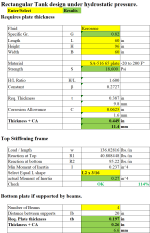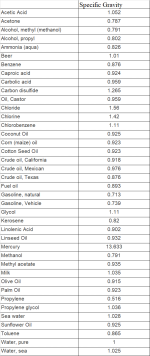Rectangular tank under hydrostatic pressure

Description
The program calculate rectangular tanks for liquid. Built in liquids, plates and stiffener material properties.
Designing a rectangular tank for liquid storage involves several steps, including material selection, wall thickness calculation, and reinforcement design. Here's a general description of how these steps might be carried out:
-
Material Selection: The user selects the material for the tank walls and stiffeners from a list of common materials. The properties of these materials, including their strength and corrosion resistance, are built into the program. The user also selects the type of liquid to be stored, and the program takes into account the properties of this liquid, such as its density and corrosiveness.
-
Wall Thickness Calculation: The program calculates the minimum required wall thickness based on the pressure exerted by the liquid, which depends on the liquid's density and the height of the tank. The formula used is typically something like:
t = ρgh / S
where:
- t is the minimum required thickness,
- ρ is the density of the liquid,
- g is the acceleration due to gravity,
- h is the height of the liquid in the tank,
- S is the allowable stress of the material.
-
Stiffener Design: To prevent the walls of the tank from buckling under the pressure of the liquid, stiffeners (reinforcing bars) are often added. The program calculates the size, number, and placement of these stiffeners based on the size of the tank, the thickness of the walls, and the properties of the material.
-
Bottom and Top Design: The bottom of the tank must be designed to support the weight of the liquid and the tank itself. The top of the tank (if it is closed) must be designed to withstand the pressure of the liquid and any external loads (such as the weight of a person walking on top of the tank).
-
Code Compliance: The program checks that the design complies with relevant codes and standards, which may specify minimum wall thicknesses, maximum allowable stresses, minimum reinforcement requirements, and other design criteria.
Please note that this is a simplified description and the actual calculations can be quite complex.
Calculation Preview
Full download access to any calculation is available to users with a paid or awarded subscription (XLC Pro).
Subscriptions are free to contributors to the site, alternatively they can be purchased.
Click here for information on subscriptions.







